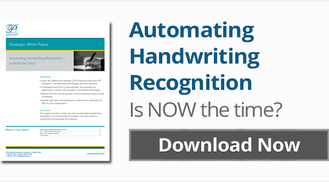Context plays a significant role in the recognition process. When people read handwriting, they look at entire words or even the entire document to correctly identify what is written. They can read a sentence and understand illegible words within the context of the document.
In the same way, recognition engines use context as an effective and flexible tool to compensate for the ambiguity of handwriting and to improve recognition accuracy. Words, or fields on a form for example, are recognized as a whole, not as a set of characters.
 For example, the character to the left might be the numeral “7” or the cursive letter “T.” Through the use of context, information such as whether the field type is alpha or numeric, recognition engines can discern which one it is. Contextual information can be as specific as a range of numbers, dates, or values, or as broad as a field type. Proper use of context helps determine the correct recognition result with a greater amount of confidence.
For example, the character to the left might be the numeral “7” or the cursive letter “T.” Through the use of context, information such as whether the field type is alpha or numeric, recognition engines can discern which one it is. Contextual information can be as specific as a range of numbers, dates, or values, or as broad as a field type. Proper use of context helps determine the correct recognition result with a greater amount of confidence.
Database cross-validation also enhances accuracy and increases read rates. Common uses include matching ZIP codes with appropriate mailing addresses for address recognition, or verifying the numeric amount (i.e., $108.35) on a check with the alphanumeric amount (i.e., One hundred eight and 35/100) for check processing applications.
Additionally, context vocabularies, customized to words and phrases that are relevant to the industry, company, or customer base, make the recognition process faster and more reliable because the vocabulary is smaller and more specific. Vocabularies provide a list of potential answers, which are used by the recognition engine to determine the best answer against potential answers while the recognition process occurs. The key point is that the comparison occurs DURING recognition. This means that the recognition engine is not interpreting characters within a word, but rather chooses the best word out of a given vocabulary.




